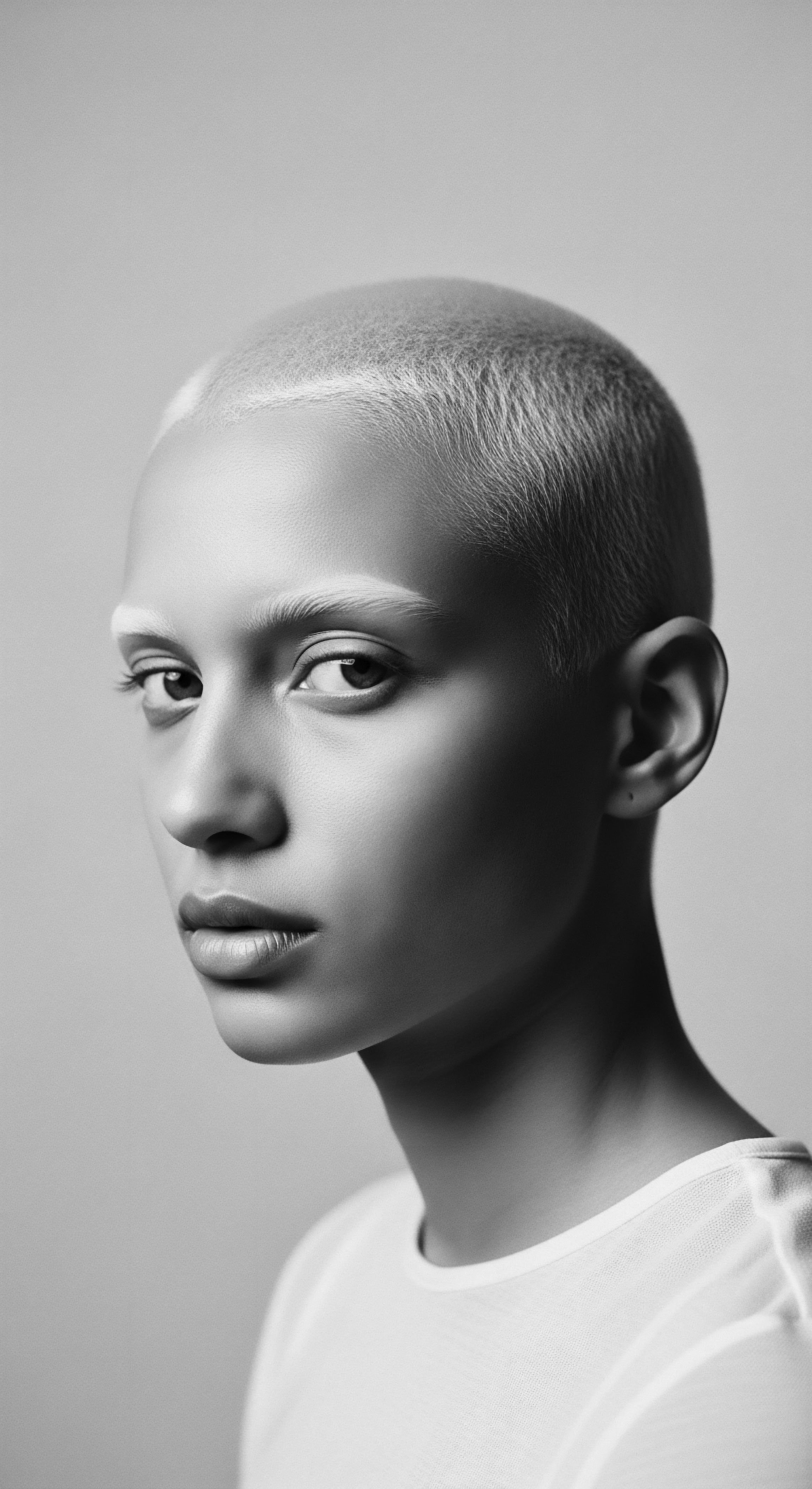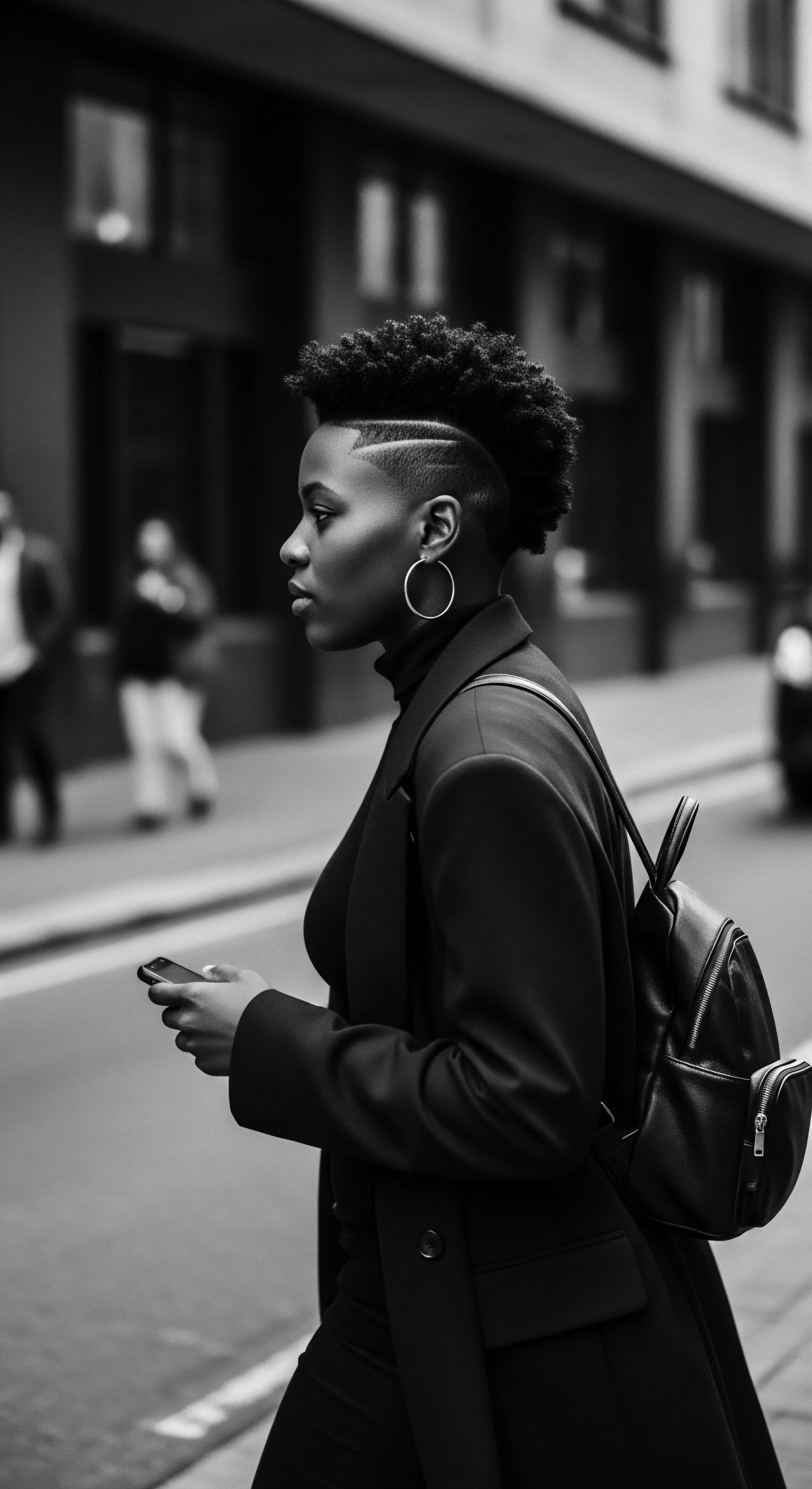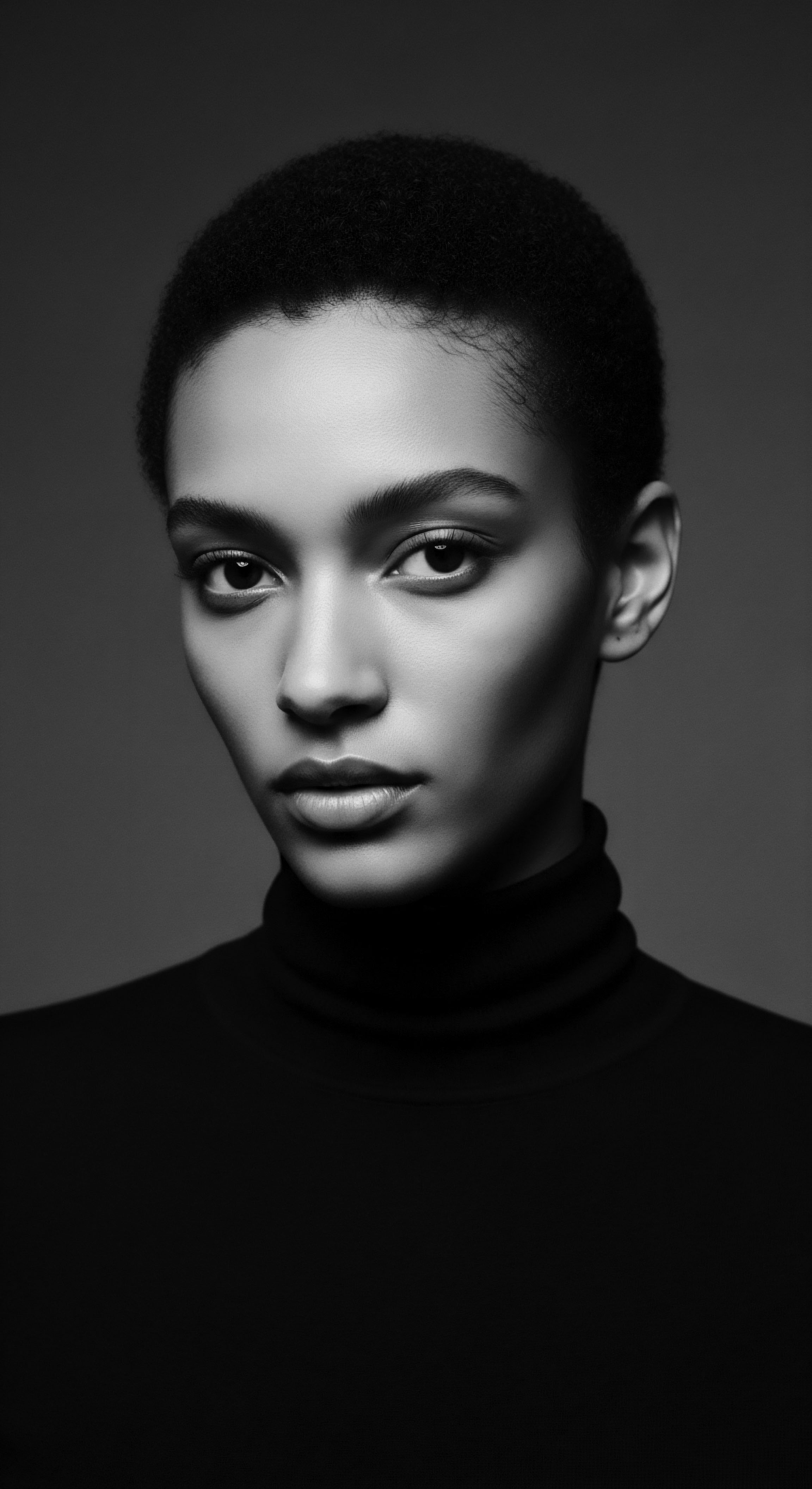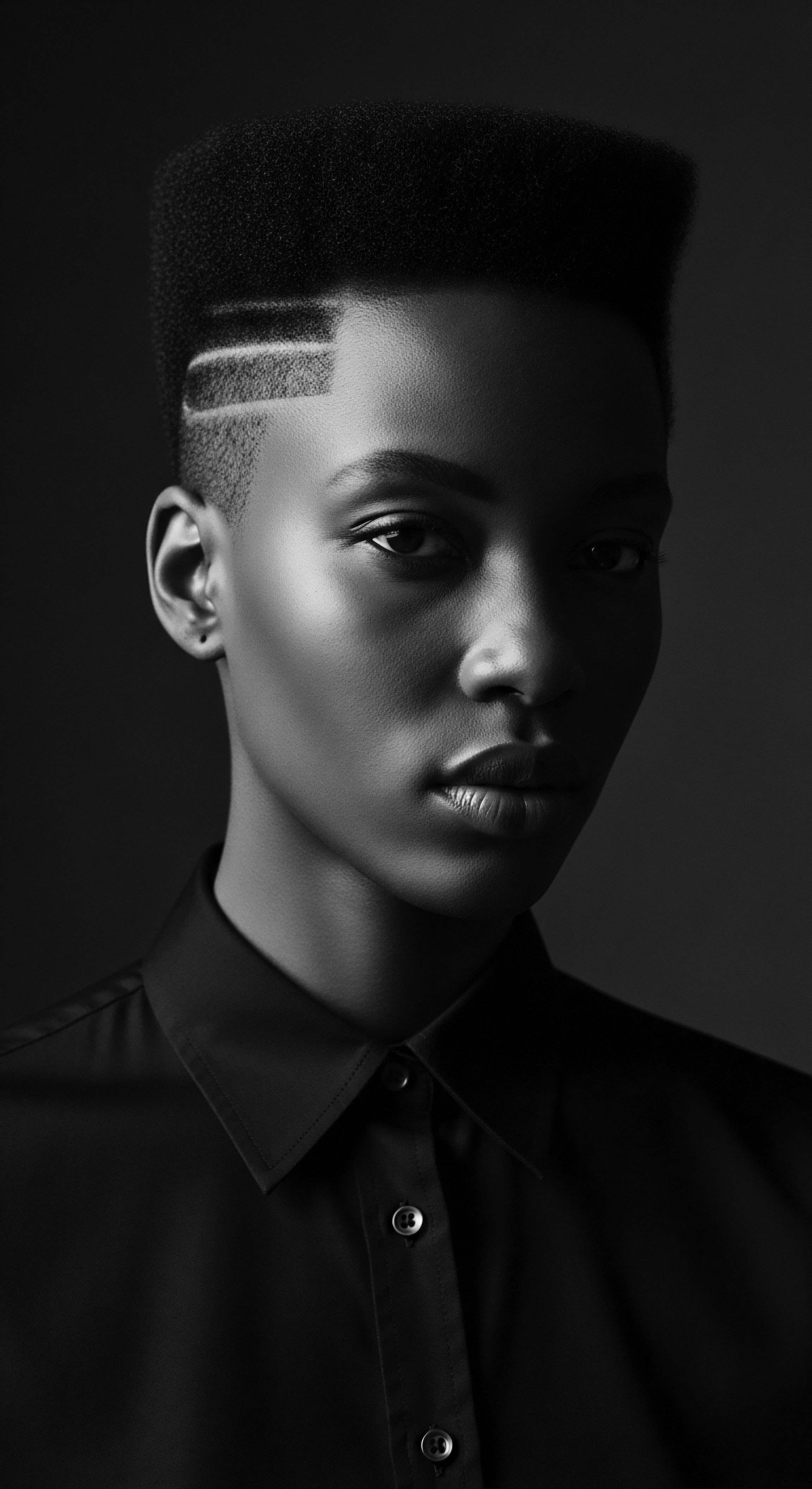
Roots
Each twist, each curl, holds a silent story. A lineage of sun-kissed resilience, a testament to ancestral ingenuity, and a profound connection to the very earth that shaped us. To truly comprehend the deep thirst of textured hair, its yearning for specific moisture, one must listen closely to these whispers from generations past.
This is not simply a matter of cosmetic science; this is a dialogue with heritage, a recognition of how biology and history intertwine within every single strand. For those with hair that coils, kinks, and waves, the relationship with hydration is a unique dance, a rhythmic interplay that speaks to an inherited wisdom passed down through time.

The Genesis of Form
At its elemental core, the distinct shape of textured hair dictates its interaction with moisture. Unlike its straighter counterparts, which possess a more circular cross-section, coily strands emerge from the scalp with an elliptical, often flattened, shape. This anatomical variance causes the hair shaft to bend and curve, creating those beautiful, tight spirals.
Each bend and curve means that the outermost layer of the hair, the Cuticle, which functions like protective shingles on a roof, does not lie as flat or smooth. Instead, these cuticles are often naturally lifted, more exposed, and thus, more susceptible to moisture loss.
Consider a meandering river versus a straight canal. The winding river, with its many turns and exposed banks, experiences greater evaporation than the direct canal. Similarly, the tortuous path of a coily strand provides more surface area for the precious water molecules to escape into the surrounding atmosphere. This fundamental biological reality underlies the perpetual quest for hydration that defines textured hair care.
The scalp’s naturally produced Sebum, an oil that provides a natural conditioning and protective layer, also struggles to descend these intricate, winding pathways. This leaves the mid-lengths and ends of the hair often drier, more vulnerable to breakage, and perpetually thirsty.

Hair’s Architectural Challenges
The very architecture of textured hair poses inherent challenges for maintaining hydration levels. The unique formation of the hair follicle itself contributes to this. When the follicle is elliptical, rather than round, it encourages the hair to grow in a spiral. This spiral creates numerous points of curvature along the strand.
At these points, the hair is naturally weaker and more prone to fracture. The lifted cuticles at these curves, while contributing to the hair’s volume and definition, also act as open doorways for moisture to vanish, making consistent external hydration a constant, critical need.

Ancestral Understanding of Hair
Long before the advent of modern trichology, ancestral communities across Africa and the diaspora possessed an intuitive, observational understanding of these characteristics. Their practices were not merely cosmetic; they were deeply rooted in a profound knowledge of the hair’s inherent needs and its symbolic significance. Hair was a living archive, a repository of identity, status, and spirit. Its health and vitality were directly connected to the individual’s well-being and their connection to community and lineage.
The unique structure of textured hair, with its elliptical shaft and lifted cuticles, creates inherent pathways for moisture escape, demanding a distinct hydration approach.
Historical accounts reveal how natural ingredients were the original chemists, providing the necessary humectants, emollients, and occlusives to preserve hair’s vitality in diverse climates. From the arid savannas to humid coastlines, indigenous wisdom adapted. The knowledge of which plants offered deep conditioning, which oils sealed the moisture within, and which clays purified without stripping, was passed down through generations.
These were not mere product applications; they were expressions of care, acts of communal bonding, and ceremonies honoring the sacredness of the strand. The very act of hair care was, and remains, a connection to a deep, unbroken chain of heritage.

Ritual
The daily and weekly acts of tending to textured hair transcend simple hygiene; they are a continuum of ancient rituals, a tender thread connecting contemporary practices to a rich ancestral past. The deep-rooted requirement for consistent moisture has shaped these rituals, transforming them into a living heritage, a tangible expression of care that has survived displacement, adaptation, and cultural shifts. Understanding why textured hair types require unique moisture strategies means acknowledging this historical flow, observing how modern scientific understanding often echoes the wisdom held in age-old customs.

The Practice of Deep Hydration Through Time
From the communal grooming sessions in ancient African villages to the intimate washday routines of today, the central aim remains constant ❉ to infuse and seal precious water into the hair. Ancestral communities, particularly in regions like Ethiopia, understood the necessity of lipid-rich applications to counteract environmental dryness. For centuries, Ethiopian women have relied upon raw, unsalted Butter, often clarified to a substance akin to ghee, as a primary agent to nourish dry hair.
Gelila Bekele, a model and activist, explains that this practice continues, with the butter applied directly to the scalp weekly and allowed to sit for hours or overnight to moisturize the hair and skin alike (Bekele, as cited in Savini, 2018). This tradition exemplifies a profound understanding of how to provide sustained moisture, long before the chemical composition of fatty acids was known.
The Liquid, Oil, Cream (LOC) or Liquid, Cream, Oil (LCO) methods, widely adopted in contemporary textured hair care to layer products for optimal moisture retention, find their parallels in these traditional practices. Ancestors utilized water, often in conjunction with various natural oils and butters, in specific sequences to ‘lock in’ hydration. This was not a codified system with acronyms, but an intuitive, handed-down knowledge of how natural elements interacted with the hair to preserve its health.

Tools and Traditional Application
The tools employed in these historical moisture rituals were as inventive as the ingredients themselves. Wide-tooth combs, often crafted from wood or bone, were essential for detangling hair, which becomes particularly prone to knotting when dry. The gentle manipulation facilitated by these tools ensured that nourishing agents could be distributed evenly from root to tip, reaching those thirsty ends that sebum struggled to coat. Head coverings, like scarves and turbans, were not solely decorative or ceremonial; they played a practical, protective role, shielding moisturized hair from the sun’s drying rays, dust, and environmental aggressors, thereby preserving hydration.
These methods, born of necessity and deep observation, formed a robust framework for hair health. The consistent application of natural emollients, the deliberate action of sealing, and the protective measures against the elements all speak to an inherent understanding of textured hair’s unique moisture needs.
- Shea Butter (Vitellaria paradoxa) ❉ A cornerstone in West African hair care, prized for its exceptional moisturizing and protective qualities, shielding hair from harsh conditions.
- Coconut Oil (Cocos nucifera) ❉ Widely used across many African and diasporic communities for its ability to penetrate the hair shaft, providing deep nourishment and reducing protein loss.
- Aloe Vera (Aloe barbadensis) ❉ Utilized for its soothing properties on the scalp and its hydrating gel, which helps to maintain moisture balance.
- Marula Oil ❉ A lightweight, antioxidant-rich oil from Southern Africa, used for its moisturizing properties without heavy residue.
- African Black Soap ❉ A traditional cleanser, derived from plantain skins and other natural ashes, used for gentle cleansing without excessive stripping.

Protective Styles ❉ A Heritage of Hydration Preservation
Protective styling represents another vital aspect of moisture management, a tradition deeply embedded in textured hair heritage. Styles such as braids, twists, and cornrows, with origins stretching back thousands of years and seen in ancient Egyptian depictions, served a dual purpose ❉ they were markers of identity and social standing, but also practical solutions for preserving hair health. By tucking away the vulnerable ends and minimizing daily manipulation, these styles dramatically reduced moisture loss, breakage, and tangling.
Protective styles, a heritage practice, serve as ingenious methods for preserving hair’s hydration and integrity by minimizing environmental exposure and manipulation.
The cultural significance of these styles is undeniable, but their efficacy in managing moisture for textured hair cannot be overstated. They created a micro-environment for the hair, allowing applied moisture to be absorbed and retained over longer periods. This strategic approach to styling, born of necessity and wisdom, is a profound example of how cultural practices have always aligned with the biological requirements of textured hair.
| Aspect Primary Moisturizer |
| Ancestral Practice Natural butters (e.g. shea, cocoa), animal fats, plant oils, ghee |
| Modern Parallel/Understanding Leave-in conditioners, moisturizing creams, deep conditioning treatments |
| Aspect Moisture Sealing |
| Ancestral Practice Layering oils and butters; head wraps (physical barrier) |
| Modern Parallel/Understanding LOC/LCO method (Liquid, Oil, Cream), hair oils as sealants |
| Aspect Protective Styling |
| Ancestral Practice Braids, cornrows, twists, threading, strategic wrapping |
| Modern Parallel/Understanding Contemporary protective styles; minimizes manipulation and environmental exposure |
| Aspect Cleansing |
| Ancestral Practice Natural clays (e.g. rhassoul), African black soap, plant washes |
| Modern Parallel/Understanding Sulfate-free shampoos, co-washing, clarifying treatments |
| Aspect The continuity of these practices underscores a timeless understanding of textured hair's need for unique moisture strategies, bridging heritage with modern care. |

Relay
The journey of textured hair and its unique moisture requirements is a profound relay, a continuous passing of understanding from one generation to the next, often against the tide of imposed beauty standards. This relay carries not only the biological truths of the strand but also the socio-cultural narratives of resilience, identity, and profound connection to heritage. Examining why textured hair types demand particular moisture strategies involves more than just a scientific inquiry; it requires a deep look into the historical forces that have shaped its care, particularly within Black and mixed-race experiences.

The Porosity Paradox ❉ A Legacy of Hydration Challenges
Modern hair science speaks of Porosity, the hair’s ability to absorb and retain moisture. Textured hair frequently exhibits higher porosity due to its lifted cuticle structure, a trait we discussed earlier. This means it can readily absorb water, but also loses it with equal swiftness. The challenge is not absorption, but retention.
This scientific explanation validates centuries of experiential knowledge. Ancestors, without scalp microscopes or pH strips, observed that their hair dried quickly and required constant reapplication of natural emollients. They understood that their hair held moisture differently, and their practices were direct responses to this inherent characteristic.
This innate predisposition for moisture loss was tragically weaponized during periods of enslavement. Upon forced arrival in the Americas, enslaved individuals were often stripped of their cultural identifiers, including their elaborate hairstyles and access to traditional hair care ingredients and tools. Slaveholders routinely shaved heads, a brutal act of dehumanization and cultural erasure. When hair grew back, the environment offered scarce resources for its proper maintenance.
Yet, against immense odds, communities devised ingenious ways to maintain their hair’s hydration, often using whatever was available on plantations. Reports detail the use of Bacon Grease, Butter, and even Kerosene as makeshift conditioners, and Cornmeal as a dry cleansing agent (Byrd & Tharps, as cited in Odele Beauty, 2021). These harrowing adaptations underscore the fundamental, unyielding need for moisture in textured hair, demonstrating an incredible will to preserve hair health, and by extension, a fragment of self and heritage, even under duress.

Hair as Resistance and Resourcefulness
The persistence of these moisture strategies goes beyond mere physical care. Hair became a site of quiet resistance and ingenious communication. It is speculated that certain braid patterns were used to convey messages or even to conceal seeds for planting at new, unknown destinations during escape attempts.
This act of carrying the physical means of sustenance within one’s hair, while simultaneously employing hair styles to manage moisture and maintain dignity, illustrates a multi-layered relationship with hair that few other cultures possess. The very act of caring for one’s textured hair became an act of defiance, a quiet assertion of humanity and connection to a lineage that colonizers sought to erase.

Validating Ancestral Wisdom with Contemporary Science
The scientific community increasingly acknowledges the efficacy of traditional ingredients that have been mainstays in textured hair care for millennia. The fatty acids in shea butter, the penetrating properties of coconut oil, and the humectant qualities of honey, all now undergo rigorous scientific scrutiny, often confirming what ancestors knew through observation and inherited wisdom. This confluence of ancient practice and modern research reinforces the idea that the “unique moisture strategies” for textured hair are not arbitrary preferences but are deeply rooted in its biological structure and sustained by a rich heritage of adaptive care.
For instance, the emphasis on lipid-rich products and methods that layer moisture, like the modern LOC method, finds a historical echo in the widespread use of oils and butters in various African cultures. These traditional applications implicitly understood the need to replenish the hair’s lipid barrier and create an occlusive layer to slow water evaporation from the open cuticles. This deep-seated knowledge, passed down through generations, became the blueprint for successful moisture management.
The historical ingenuity of textured hair care, from using repurposed fats during enslavement to intricate braided messages, illuminates a deep, defiant connection to moisture preservation and identity.
A powerful instance of this historical continuity, demonstrating both enduring need and persistent ingenuity, comes from the practice of Hair Wrapping. Beyond aesthetic and ceremonial purposes, head wraps and scarves provided a crucial layer of protection, particularly at night, to prevent moisture evaporation and mechanical damage. This practice, still widely used today, reduces friction against rough surfaces like cotton pillowcases, which can strip hair of its natural oils and applied moisture. This traditional understanding of environmental protection aligns perfectly with modern recommendations for satin bonnets and pillowcases, highlighting a timeless concern for moisture preservation.
The requirement for unique moisture strategies for textured hair is therefore not merely a biological imperative; it is a cultural legacy. It is a story of adaptation, survival, and profound self-worth, where the very acts of hydrating and protecting hair have become synonymous with upholding a heritage that refuses to be diminished.
This heritage compels us to acknowledge that hair care for textured strands is a sophisticated, multi-generational conversation that blends empirical observation, scientific understanding, and profound cultural memory. The inherent characteristics of textured hair have always necessitated a specialized approach to moisture, giving rise to unique strategies that have been refined and passed down, enduring through trials and triumphs.
It is through this lens that we see why products and practices developed for straighter hair types often fall short for textured hair. Their moisture delivery and retention mechanisms may not adequately address the open cuticles, the extensive surface area, or the uneven distribution of natural oils that characterize coils and kinks. The wisdom of our ancestors, combined with modern scientific inquiry, affirms that a tailored approach to hydration is not a luxury, but a fundamental right for textured hair to thrive, a right hard-won and lovingly preserved through countless generations.

Reflection
As we conclude this exploration of why textured hair types require unique moisture strategies, we stand at a crossroads where the elemental biology of a strand meets the boundless spirit of generations. This discussion extends beyond the mere application of products; it is an honoring of a profound legacy. Every drop of water, every nourishing butter, every protective style, contributes to a living archive of resilience, wisdom, and an unwavering commitment to self-definition.
The intrinsic nature of textured hair, with its remarkable coils and delicate structure, compels a specific devotion to hydration. This is not a deficit, but a design that inspires unique solutions. The ancestral hands that once braided messages into tresses and coated strands with shea butter were not simply styling hair; they were performing acts of preservation, not just for the hair, but for identity itself. This continuum of care is what defines the ‘Soul of a Strand’ – a recognition that hair holds memory, culture, and power.
Our understanding of textured hair’s moisture needs is a tapestry woven from the threads of botanical knowledge, scientific discovery, and the lived experiences of Black and mixed-race communities. It speaks to a deep, inherent knowledge that predates laboratories and commercial markets, a wisdom rooted in observation and adaptation. To truly care for textured hair is to listen to this heritage, to respect its needs, and to celebrate the enduring beauty that emerges from this unique relationship with moisture. The journey of hydration for textured hair is a testament to perseverance, a radiant expression of a heritage that will forever bloom.

References
- Byrd, Ayana D. & Tharps, Lori L. (2001). Hair Story ❉ Untangling the Roots of Black Hair in America. St. Martin’s Press.
- Hooks, bell. (1992). Black Looks ❉ Race and Representation. South End Press.
- Mercer, Kobena. (1994). Welcome to the Jungle ❉ New Positions in Black Cultural Studies. Routledge.
- Patton, Tracey Owens. (2006). African-American Hair as Culture and Commodity ❉ A Social History. University of North Carolina Press.
- Rooks, Noliwe M. (1996). Hair Raising ❉ Beauty, Culture, and African American Women. Rutgers University Press.
- Savini, Loren. (2018). “What Hair Care Means to Women Around the World.” Allure.com. (Cited through Cornell University’s Africana Studies and Research Center, accessed in research).
- Walker, Alice. (1990). The Temple of My Familiar. Harcourt Brace Jovanovich.
